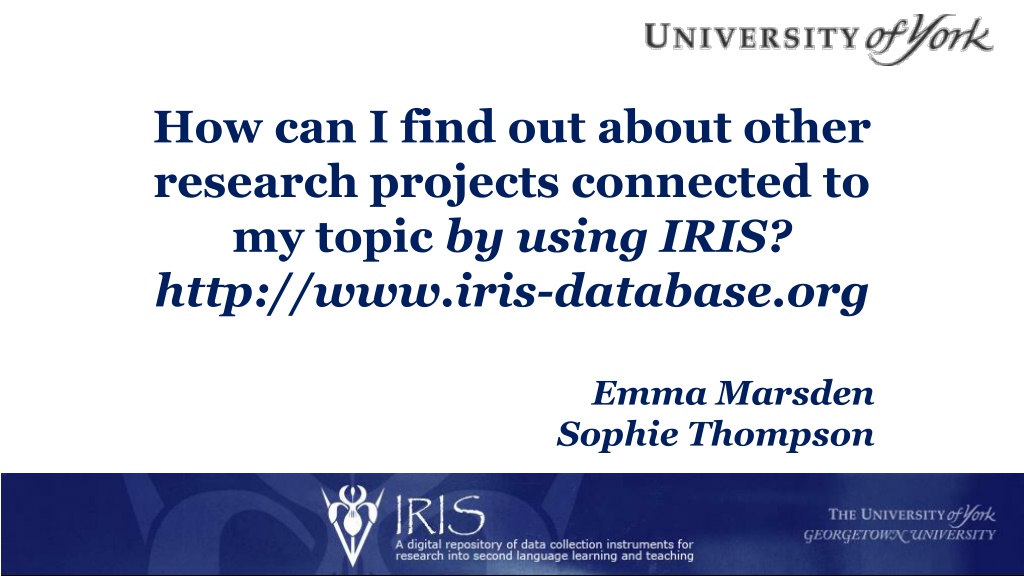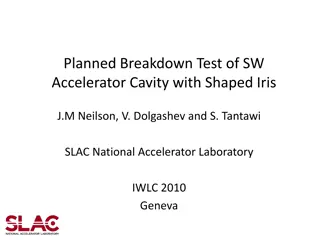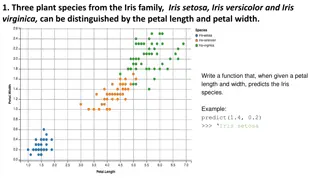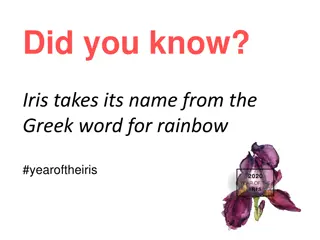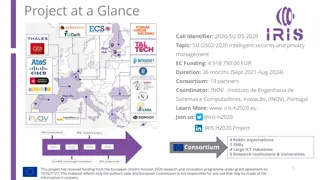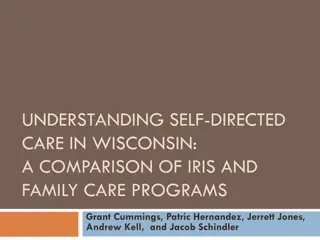Finding Research Projects Related to Your Topic Using IRIS
IRIS is a repository of materials for research in second language learning and teaching, offering a vast array of methods and topics. You can access data collection instruments and published research materials. This webinar showcases possible action research areas for EFL classrooms, with examples like student silence, learner needs, and feedback. Explore studies like "Interactional Context and Willingness to Communicate" to adapt research methods for your own classroom.
Download Presentation

Please find below an Image/Link to download the presentation.
The content on the website is provided AS IS for your information and personal use only. It may not be sold, licensed, or shared on other websites without obtaining consent from the author.If you encounter any issues during the download, it is possible that the publisher has removed the file from their server.
You are allowed to download the files provided on this website for personal or commercial use, subject to the condition that they are used lawfully. All files are the property of their respective owners.
The content on the website is provided AS IS for your information and personal use only. It may not be sold, licensed, or shared on other websites without obtaining consent from the author.
E N D
Presentation Transcript
How can I find out about other research projects connected to my topic by using IRIS? http://www.iris-database.org Emma Marsden Sophie Thompson
What is IRIS? Repository of materials used to collect data for research Free, open-access Second language learning and teaching Huge range of methods, approaches, research topics, All materials have been used for peer-reviewed published research 1700 files -> 700 instruments for collecting data 9,500 downloads. 1/5 from teachers and teacher educators Sustainable long term funding
This webinar will outline areas of possible action research for the EFL classroom. The research suggested will help you to answer some common questions that as teachers we have all asked. The areas covered will be: Student silence in class Learner needs and motivation Materials development Classroom feedback Five previous pieces of research, all accessible on IRIS will be outlined and some suggestions of how you might use the research in your own classes will be given.
1) Why are my students sometimes unwilling to communicate in class? Cao, Y. & Philp, J. (2006). Interactional context and willingness to communicate: A comparison of behaviour in whole class, group and dyadic interaction. System,34(4), 480-493
Title / type of instrument(s): Interview/self-report questions and observation schedule Aim of the study: to investigate students feelings about their willingness to communicate and determine which classroom activities promote student interaction. Sample size: 10 Ages: 20-50 Proficiency: intermediate Design: Willingness to communicate questionnaire on day one of the course, 2/week observations over 4 weeks, interview in the final week. Findings: learners behaved differently in different contexts learners preferences varied across individuals teachers should make use of varied interaction patterns in classes
How could you adapt this study? use the questionnaires to regularly allow learners to assess their WTC and adapt classroom interaction accordingly (in particular the questions assessing classroom activities) use the observation schedule to carry out CPD and to raise awareness of the value of different interaction types run a full replica study using a bigger sample/different learners use as a needs analysis for new students to determine their communication preferences Issues the WTC questionnaire will need adapting to match your learners experience you could do this in the learners L1 with lower levels 8 observations is quite time-consuming so the observation scheme could be adapted to be a self-report scheme to raise teachers awareness
2) How do my learners feel about learning English? Taylor, F. (2010) A quadripolar model of identity in adolescent foreign language learners.
Title / type of instrument(s): Student questionnaire (available in Spanish and English) Aim of the study: to investigate how students identity varies in the classroom and how this affects learning and attainment Sample size: 1045 Ages: 14-19 Proficiency: intermediate + Design: questionnaire given to students and took around 30 minutes to complete. Follow-up interviews were carried out with volunteers (see appendix B in the article for guide) Findings: students appeared to have different selves or fronts at different times most students believed the teacher could control their motivation boys and girls differed greatly (boys had stronger private-selves if teachers knew students better the classes would be more interesting
How could you adapt this study? use as a start of term activity to get to know your students better use the interview questions as a basis for a needs analysis/learner styles session in the first class - could encourage learners to come to the next class. use collaboratively with students to determine their different selves - could be a mini project investigate gender differences further Issues the wording will need adapting for adult learners this was only carried out in Romania - gender differences might be less of an issue in other countries (worth exploring) the causes of students responses were not fully investigated
3) Are the materials I use communicative enough? Barrot, J. (2012). Towards the development and validation of a sociocognitive- transformative materials design model for ESL learners.
Title / type of instrument(s): rating scale for materials assessment Aim of the study: to create a model to help teachers assess the materials they use Sample size: 10 experienced teachers - experience ranged from 15-45 years Design: model was used to test materials designed to include cognitive, social, cultural, and transformative components of learning (see for further information). Findings: material appeared to be successfully evaluated using the scale and was rated as including the target components (above).
How could you adapt this study? use the rating scale to evaluate your materials/your school s materials use the items on the scale to give you ideas when developing materials e.g. create material (which) reflects social interaction and collaboration for language learning . use items from the scale as a focus for materials development sessions as part of CPD e.g. material promoting authentic language experience among learners. Issues very complex set of criteria - will need to be broken down for most of the above uses not all criteria will be appropriate for your needs (be selective) probably most useful as a guide rather than as a exhaustive set of criteria that must be met for all material
4) Why are my learners studying English? What motivates them? You, C., & D rnyei, Z. (in press). Language learning motivation in China: Results of a large-scale stratified survey. Applied Linguistics.
Title / type of instrument(s): motivation questionnaire Aim of the study: to determine what motivates L2 learners of English (in China) Sample size: 10,413 Age: 16 -19 (average age range) Proficiency: various levels: upper-intermediate + Design: questionnaires sent to learners and completed individually Findings: leaners were motivated by both the positive image learning English appears to have and by the drive to do well outside school, e.g. in work or university. results were in-line with findings from other countries and cultures
How could you adapt this study? use as a needs analysis for your learners at the start of term - this could be repeated at different points to see if motivation changes use as the basis for assessing motivation and then apply to setting goals for the learners to use throughout the year carry out on a wider scale to assess learners in your country Issues the original was a huge study carried out only in China - would your country see different results the study only looked at teens and young adults - what about older learners? implications for teachers are not discussed much in the original - a smaller study with a focus on using the motivational knowledge gained in class planning would be beneficial
5) What kind of feedback should I give during tasks? Mackey, A., & Silver, R. E. (2005). Interactional tasks and English L2 learning by immigrant children in Singapore. System, 33 (2)
Title / type of instrument(s): communicative activity and feedback plan Aim of the study: to find out if feedback during a tasks improves use of target language Sample size: 26 Age: 6-9 Proficiency: pre-intermediate Design: Various tasks focusing on question forms were given (one example above) one group of children received on-going feedback and help during the tasks whereas another group did not. Findings: those who received feedback during the tasks improved production of correct question forms over the period of practice.
How could you adapt this study? use the feedback plan to vary the type of teacher interaction in classes use as the basis for observation of teachers to improve interactional feedback in class adapt and use with other communicative tasks at other levels e.g. Cambridge certs. picture tasks and decision making tasks Issues only done with small children - how would it work with adults or more advanced learners will work better with a range of communicative tasks - the one given is only an example e.g. meet-your-partner, picture ordering, story-board, information gap type of feedback given will vary across different levels
Summary Today we have: Presented some ideas for how to carry out research in your classrooms Made some suggestions for how past materials can be adapted for small-scale research Provided some instruments that can be used or built on for CPD or for action research Demonstrated how IRIS is a great resource for teachers to access for ideas and ready-made instruments for use in research or CPD.
The next stage is over to you!! Please feel free to use the materials provided today or get on IRIS and start looking for other research ideas from the hundreds you can find there. Thank you for taking the time to learn more about IRIS today.
